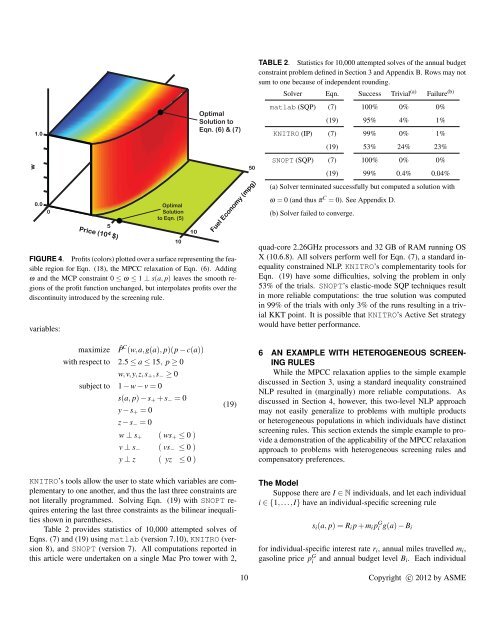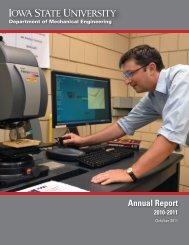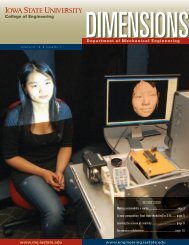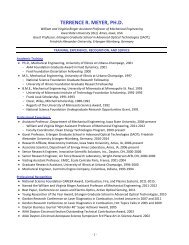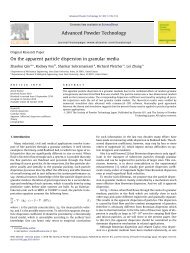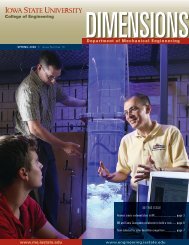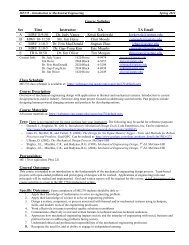Consider-then-Choose Models in Decision-Based Design ...
Consider-then-Choose Models in Decision-Based Design ...
Consider-then-Choose Models in Decision-Based Design ...
Create successful ePaper yourself
Turn your PDF publications into a flip-book with our unique Google optimized e-Paper software.
w<br />
1.0<br />
0.0<br />
0<br />
5<br />
Price (10 4 $)<br />
Optimal<br />
Solution<br />
to Eqn. (5)<br />
10<br />
10<br />
Optimal<br />
Solution to<br />
Eqn. (6) & (7)<br />
50<br />
Fuel Economy (mpg)<br />
FIGURE 4. Profits (colors) plotted over a surface represent<strong>in</strong>g the feasible<br />
region for Eqn. (18), the MPCC relaxation of Eqn. (6). Add<strong>in</strong>g<br />
ω and the MCP constra<strong>in</strong>t 0 ≤ ω ≤ 1 ⊥ s(a, p) leaves the smooth regions<br />
of the profit function unchanged, but <strong>in</strong>terpolates profits over the<br />
discont<strong>in</strong>uity <strong>in</strong>troduced by the screen<strong>in</strong>g rule.<br />
variables:<br />
TABLE 2. Statistics for 10,000 attempted solves of the annual budget<br />
constra<strong>in</strong>t problem def<strong>in</strong>ed <strong>in</strong> Section 3 and Appendix B. Rows may not<br />
sum to one because of <strong>in</strong>dependent round<strong>in</strong>g.<br />
Solver Eqn. Success Trivial (a) Failure (b)<br />
matlab (SQP) (7) 100% 0% 0%<br />
(19) 95% 4% 1%<br />
KNITRO (IP) (7) 99% 0% 1%<br />
(19) 53% 24% 23%<br />
SNOPT (SQP) (7) 100% 0% 0%<br />
(19) 99% 0.4% 0.04%<br />
(a) Solver term<strong>in</strong>ated successfully but computed a solution with<br />
ω = 0 (and thus π C = 0). See Appendix D.<br />
(b) Solver failed to converge.<br />
quad-core 2.26GHz processors and 32 GB of RAM runn<strong>in</strong>g OS<br />
X (10.6.8). All solvers perform well for Eqn. (7), a standard <strong>in</strong>equality<br />
constra<strong>in</strong>ed NLP. KNITRO’s complementarity tools for<br />
Eqn. (19) have some difficulties, solv<strong>in</strong>g the problem <strong>in</strong> only<br />
53% of the trials. SNOPT’s elastic-mode SQP techniques result<br />
<strong>in</strong> more reliable computations: the true solution was computed<br />
<strong>in</strong> 99% of the trials with only 3% of the runs result<strong>in</strong>g <strong>in</strong> a trivial<br />
KKT po<strong>in</strong>t. It is possible that KNITRO’s Active Set strategy<br />
would have better performance.<br />
maximize ˆP C (w,a,g(a), p)(p − c(a))<br />
with respect to 2.5 ≤ a ≤ 15, p ≥ 0<br />
w,v,y,z,s + ,s − ≥ 0<br />
subject to 1 − w − v = 0<br />
s(a, p) − s + + s − = 0<br />
y − s + = 0<br />
z − s − = 0<br />
w ⊥ s + ( ws + ≤ 0 )<br />
v ⊥ s − ( vs − ≤ 0 )<br />
y ⊥ z ( yz ≤ 0 )<br />
(19)<br />
6 AN EXAMPLE WITH HETEROGENEOUS SCREEN-<br />
ING RULES<br />
While the MPCC relaxation applies to the simple example<br />
discussed <strong>in</strong> Section 3, us<strong>in</strong>g a standard <strong>in</strong>equality constra<strong>in</strong>ed<br />
NLP resulted <strong>in</strong> (marg<strong>in</strong>ally) more reliable computations. As<br />
discussed <strong>in</strong> Section 4, however, this two-level NLP approach<br />
may not easily generalize to problems with multiple products<br />
or heterogeneous populations <strong>in</strong> which <strong>in</strong>dividuals have dist<strong>in</strong>ct<br />
screen<strong>in</strong>g rules. This section extends the simple example to provide<br />
a demonstration of the applicability of the MPCC relaxation<br />
approach to problems with heterogeneous screen<strong>in</strong>g rules and<br />
compensatory preferences.<br />
KNITRO’s tools allow the user to state which variables are complementary<br />
to one another, and thus the last three constra<strong>in</strong>ts are<br />
not literally programmed. Solv<strong>in</strong>g Eqn. (19) with SNOPT requires<br />
enter<strong>in</strong>g the last three constra<strong>in</strong>ts as the bil<strong>in</strong>ear <strong>in</strong>equalities<br />
shown <strong>in</strong> parentheses.<br />
Table 2 provides statistics of 10,000 attempted solves of<br />
Eqns. (7) and (19) us<strong>in</strong>g matlab (version 7.10), KNITRO (version<br />
8), and SNOPT (version 7). All computations reported <strong>in</strong><br />
this article were undertaken on a s<strong>in</strong>gle Mac Pro tower with 2,<br />
The Model<br />
Suppose there are I ∈ N <strong>in</strong>dividuals, and let each <strong>in</strong>dividual<br />
i ∈ {1,...,I} have an <strong>in</strong>dividual-specific screen<strong>in</strong>g rule<br />
s i (a, p) = R i p + m i p G i g(a) − B i<br />
for <strong>in</strong>dividual-specific <strong>in</strong>terest rate r i , annual miles travelled m i ,<br />
gasol<strong>in</strong>e price p G i and annual budget level B i . Each <strong>in</strong>dividual<br />
10 Copyright c○ 2012 by ASME


